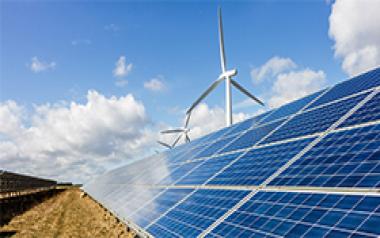The natural energy sources which are also called renewable energy sources are continuously produced by natural processes and forces occurring in our environment. Generally renewable energy sources are inexhaustible sources of energy available abundantly in the environment.
Various types of Renewable Energy Sources are as:
Solar energy is the most popular form of producing electricity and heat now a days. Through Solar photovoltaic effect light energy is converted to electricity.
Solar energy can be further classified into two categories
Solar PV System
Solar PV system converts Sun’s radiation to into electricity thorough photovoltaic effect. The generated electricity is stored in battery which is used further for many applications.
The basic components of solar PV systems are as follows:
In solar thermal technology the solar radiation is converted to heat energy. A device called solar collector is used for converting solar radiation into heat energy. Solar water heater is widely used in hospitals, hotels and other large scale community for generation of hot water used in many applications.
A moving object possesses energy due to its motion , this is called the kinetic energy. Similarly flow of air or wind , around the earth possesses kinetic energy. The kinetic energy of the blowing wind is called wind energy. The flow of wind in our atmosphere is mainly caused by uneven heating of the earth’s surface by the Sun. thus wind energy is indirect manifestation of sun’s energy. The wind energy is has good potential to be a source of renewable and pollution free power. About 1 to 3% of the solar energy falling on earth surface gets converted to wind energy. The conversion of wind energy to electrical energy is one of the most successful renewable energy technology.
Biomass refers to the mass of biological material produced from the living processes. This includes the materials derived from the plants as well as animals. Chemically, biomass refers to the materials containing hydrogen, carbon and oxygen. We extract biomass from numbers sources like plants, trees, agricultural crops, raw materials from forest, household waste and wood. The contribution of the biomass to our energy requirement comes in the form of food and fuel. There are various other requirements that are being served by the use of biomass, namely shelter preparation, fodder for animals, nutrient for soil etc. the earliest inhabitants on the earth burned wood in their campfires for heat and since then it has been a source of energy for meeting human needs. As a renewable energy source , biomass should be able to meet all its requirements in various forms, provided the balance between production and consumption of biomass is maintained.
Energy can be generated from bio degradable items, such as plants, cow dung, leaves etc. these items are rich in hydrocarbons and release energy when burned. The main application of biomass energy fuel generation which is use d foe cooking as well as vehicular transport applications. Biodiesel is one of the most important products of biomass. Cooking gas from biomass, also called biogas s also an important source of energy. Using a process called gasification, biomass can be also be converted into fuel gas, which can be used in engine in place of diesel.
An object kept at height, is said to possess some energy called potential energy, because a falling object can provide some energy. For instance, in hydro power plants energy of water falling from a certain height is used to generate electrical energy. Water falling from a height has stored potential energy. This energy is could be then used to rotate the hydro turbines for generation of electricity.
The earth is large sphere. The surface of this sphere is cold but its center is still very hot. Core of the earth is plasma which is at very high temperatures about 5000o C while the earth surface temperature less than 100oC . Due to temperature gradient , there is always heat conduction could be used for heat and electricity generation. Special types of heat exchangers are used for conversion of heat generated in the earth to the end applications, such as steam generation for process heat or for electricity generation.
Tidal power or tidal energy is form of hydropower that converts the energy obtained from tides into useful form of energy, mainly electricity. Although it is not widely used, tidal energy has potential for future energy generation.
